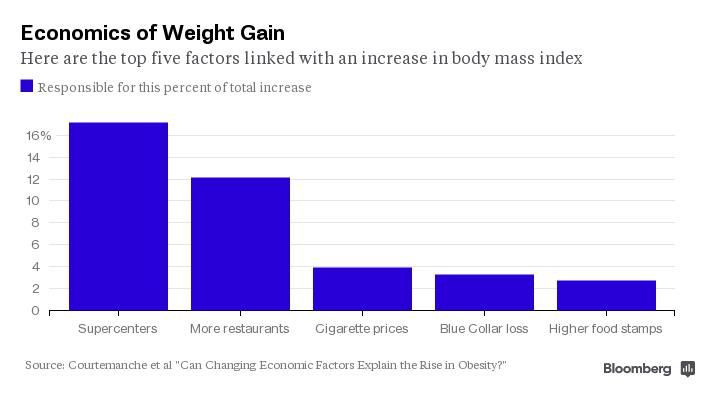Cheap Food, More Wal-Marts Contribute To Rising Obesity Rates: How The Economy Is Making You Fat

The economy plays a fairly large role in the national obesity epidemic, according to a new working paper published by the National Bureau of Economic Research.
From 1990 to 2010, the average Body Mass Index (BMI) in the U.S. increased by 37 percent — and there was a shocking 59 percent rise in severe obesity during that time as well. The paper claims that economic factors, like the price of food, prevalence of giant supermarkets like Wal-Mart, and the types of jobs in each state were behind the increase in obesity in the country.
One of the factors, according to the study, is the growing amount of supercenters that sell bigger amounts of food for cheap. We’re talking about Wal-Mart here. The authors found that people were heavier when the cost of calories decreased, and this accounted for 36.5 percent of total BMI gains.
Ironically enough, they also found that people living near supercenters were more likely to try to lose weight, but their attempts were cancelled out by buying cheap food in bulk then probably not eating it in moderation. “Supercenter/warehouse club density increases the probability of weight-loss attempts,” the authors write, “raising the possibility that cheap food from these retailers triggers self-control problems.”
In low-income, poverty-stricken areas, people are far more likely to buy cheap food, and cheap food is usually the stuff that’s packed with salt, sugar, and partially hydrogenated oils. In addition, poorer and more rural parts of the country are often labelled food deserts — where the only grocery stores or gas stations available for miles don’t provide fresh fruits or vegetables, but only junk food.
Of course, people struggling financially often don’t have other options other than Wal-Mart and McDonald’s. Which poses the question of whether these large corporations are partially responsible for the obesity epidemic as well. And, mind you, they are certainly trying to change their ways: McDonald’s has ushered out new healthy meal options including salads and fruit, and Wal-Mart states it’s applying its resources towards making healthy eating more available in its stores. But it’s possible all of this might be too little too late.
Other economic factors contributing to the rise in obesity included a larger amount of restaurants, cigarette prices, loss of blue collar jobs, and higher food stamps, as depicted by the Bloomberg graph below:

A paper published by the same group, the National Bureau of Economic Research, last year found similar results: that food prices could be causing the childhood obesity epidemic. The authors suggested that perhaps taxing unhealthy food, or subsidizing healthy ones, could help fight the growing epidemic.
And the authors of the newest paper aren’t going to be completely negative: they provide some glimmers of hope by pointing out that certain things are correlated with decreasing obesity rates, such as fitness centers, higher gas prices (probably forcing people to walk or bike more, and drive less), and unemployment.
Source: Courtemanche C, Pinkston J, Ruhm C, Wehby G. “Can Changing Economic Factors Explain the Rise in Obesity?” The National Bureau of Economic Research, 2015.
Published by Medicaldaily.com



























